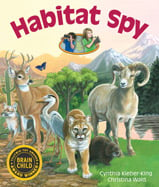Alignment to Standards for MS

| Grade | Number | Standard |
|---|---|---|
| 1 | 1)3.a. | Classify animals and plants by observable features (e.g., size, appearance, color, motion, habitat). |
| 1 | 1)3.b. | Identify Earth landforms and bodies of water (e.g., continents, islands, peninsulas, oceans, rivers, lakes, ponds, creeks). |
| 1 | 1)3.e. | basic needs of plants and animals and recognize that plants and animals both need to take in water, animals need food, and plants need light. |
| 1 | 1)3.f. | Identify and label the parts of a plant. |
| 1 | SS 1)5.a | Identify settings of read-aloud stories as geographic locations |
| 2 | 2)3.a. | Describe and categorize the characteristics of animals (vertebrates or invertebrates, cold-blooded or warm-blooded) |
| 2 | 2)3.a. | Describe and categorize the characteristics of plant parts (leaves, stems, roots, and flowers) |
| 2 | 2)3.e.2 | Investigate and explain the interdependence of plants and animals: Predator-prey relationships |
| 3 | 3)3.a. | diverse life forms (including vertebrates and invertebrates) that live in different environments (e.g., deserts, tundras, forests, grasslands, taigas, wetlands) and the structures that serve different functions in their survival (e.g. |
| 3 | 3)3.c. | relationships between the basic needs of different organisms and discern how adaptations enable an organism to survive in a particular environment. |
| 3 | 3)3.e. | Recall that organisms can survive only when in environments (deserts, tundras, forests, grasslands, taigas, wetlands) in which their needs are met and interpret the interdependency of plants and animals within a food chain, including producer, consumer, d |
| 3 | SS 3)5.b | Compare/contrast animals/habitats from different countries (elephants, lions, zebras, desert, savannah, etc.). |
| 4 | 4)3.a.1 | Observable traits due to inherited or environmental adaptations |
| 4 | 4)3.c. | Compare characteristics of organisms, including growth and development, reproduction, acquisition and use of energy, and response to the environment. |
| 4 | 4)3.c.2 | Plant or animal structures that serve different functions in growth, adaptation, and survival |
| 4 | 4)3.e. | Analyze food webs to interpret how energy flows from the sun. |
| 4 | 4)4.b.1 | Compare and contrast Earthês geological features: Bodies of water, beaches, ocean ridges, continental shelves, plateaus, faults, canyons, sand dunes, and ice caps |
| 5 | 5)3.a.1 | Diversity based on kingdoms, phyla, and classes (e.g., internal/external structure, body temperature, size, shape) |
| 5 | 5)3.b.1 | Research and classify the organization of living things: Differences between plant and animal cells |
| K | K)3.a | Group animals and plants by their physical features (e.g., size, appearance, color). |
| K | K)3.e. | Recognize and compare the differences between living organisms and non-living materials. |
| K | K)4.e.1 | Describe the effects of the sun on living and non-living things: Warms the land, air, and water |
| K | K)4.e.2 | Describe the effects of the sun on living and non-living things: Helps plants grow |